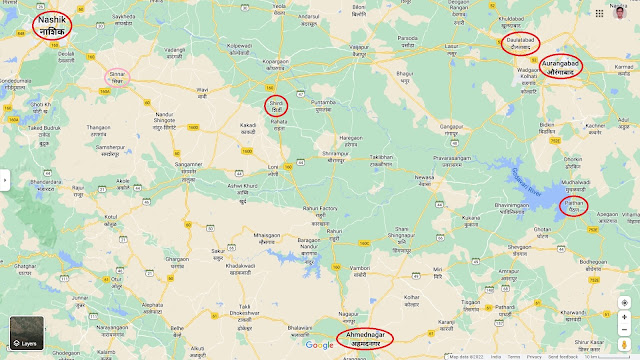Cities whose history can tell us Shirdi area history of rulers from 1000 AD to 2000 AD, are: Nashik, Paithan, Devagiri (Daulatabad), Ahmednagar from 1490 and Aurangabad from 1610
Minor update on 20th Dec. 2022
This post follows up on my previous post: 13th century AD history of kingdom that ruled Shirdi and nearby areas, related to name Hemadpant used by Shirdi Sai Baba to refer to Govind Raghunath Dabholkar , https://ravisiyer.blogspot.com/2022/12/13th-century-ad-history-of-kingdom-that.html .
Around 1000 AD, the cities close to Shirdi (around 100 kms or less by road) that existed about whom info. is easily available on Internet today, were Nashik, Sinnar, Paithan and Devagiri (later renamed to Daulatabad). See below pic.
[On PC desktop/laptop, to open pic in larger resolution (if available), right-click on pic followed by open link (NOT image) in new tab/window. In new tab/window you may have to click on pic to zoom in.]
But wiki page of Sinnar provides no data related to it being a major city of ancient empires. That leaves us with Nashik, Paithan and Devagiri as the 1000 AD or earlier cities close to Shirdi.
Paithan and Devagiri are close to Aurangabad. https://en.wikipedia.org/wiki/Aurangabad states, "Paithan, the imperial capital of the Satavahana dynasty (1st century BCE–2nd century CE), as well as Dēvagirī, the capital of the Yadava dynasty (9th century CE–14th century CE), are located within the limits of modern Aurangabad." I don't know what exactly that statement means as Daultabad is very close to Aurangabad city center (distance of around 17 km reported by Google) but Paithan is not so close (distance of around 51.4 km from Aurangabad city center).
Modern Aurangabad city seems to have been founded as Khadki in 1610. Related extract from above wiki page: "In 1610, a new city named Khaḍkī was established at the location of modern Aurangabad to serve as the capital of the Ahmadnagar Sultanate by the Ethiopian military leader Malik Ambar, who was brought to India as a slave but rose to become a popular Prime Minister of the Ahmadnagar Sultanate. Malik Ambar was succeeded by his son Fateh Khan, who changed the name of the city to Fatehnagar. In 1636, Aurangzeb, who was then the Mughal viceroy of the Deccan region, annexed the city into the Mughal Empire. In 1653, Aurangzeb renamed the city as "Aurangabad" and made it the capital of the Deccan region of the Mughal Empire."
So till 1610, we need to focus on history of Paithan and Devagiri rather than that of Aurangabad.
Ahmednagar wiki page, https://en.wikipedia.org/wiki/Ahmednagar , states, "The town Ahmednagar was founded in 1490 by Ahmad Nizam Shah I on the site of a more ancient city, Bhingar. With the breakup of the Bahmani Sultanate, Ahmad established a new sultanate in Ahmednagar, also known as Nizam Shahi dynasty.[9]" There is a wiki page for Bhingar, https://en.wikipedia.org/wiki/Bhingar , but the page does not mention it being a major city of any ancient empire/kingdom.
So till 1490, we can ignore Ahmednagar.
That leads to following we need to study:
From 1000 AD to 1490: Nashik, Paithan and Devagiri(Daulatabad)
From 1490: Add Ahmednagar to above
From 1610 to 2000: Add Aurangabad to above and drop Paithan and Devagiri from above
Any suggestions/constructive criticism are welcome.
[I thank Wikipedia and Google Maps, and have presumed that they will not have any objections to me sharing the above extract(s)/map from their website on this post which is freely viewable by all, and does not have any financial profit motive whatsoever.]

Comments
Post a Comment